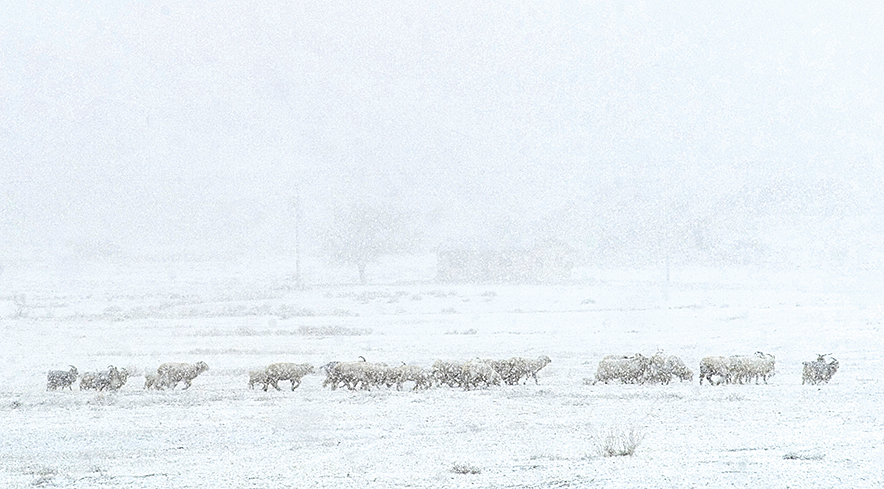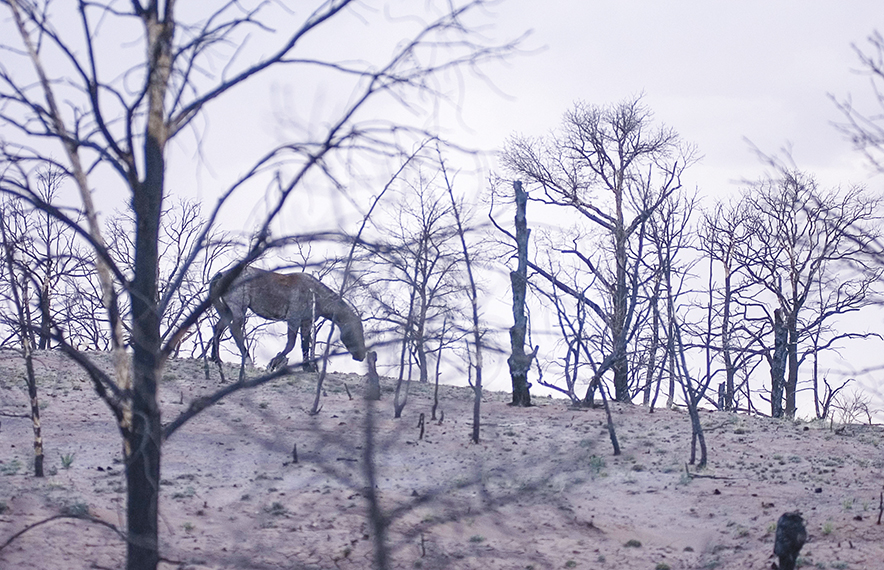
Climate change in Diné Bikéyah: a crisis of land, water, and wildlife

Special to the Times | Donovan Quintero
A herd of sheep and goats make their way through a snowstorm in Buffalo Springs, N.M., north of Tohatchi.
Robert Bettis
Navajo Times
WINDOW ROCK – As climate change impacts Diné Bikéyah, residents and environmental experts are grappling with its far-reaching consequences, from severe droughts to the overpopulation of feral animals that deplete natural resources.
According to Keith Howard, the program leader at the Navajo Nation Department of Fish and Wildlife’s Climate Change Program, these issues are interconnected, creating a compounding crisis for the land and its inhabitants.
Climate indicators and challenges
The signs of climate change are becoming more evident every year. Extreme weather events, such as flash floods, microburst rainfalls, and even tornadoes – once rare in the region – are being reported more frequently. Navajo Nation residents say that even snowfall seems inconsistent and often melts quickly, leaving the land exposed to the heat that drives further evaporation and soil degradation.

Special to the Times | Donovan Quintero
A horse covered by ash and soot grazes trough destroyed by a brush fire near Kinlichee, Ariz.
Howard highlighted how climate change strains an already vulnerable population. “About 30% of Navajo households lack running water, forcing residents to haul water for both personal use and livestock,” he says.
With less native vegetation available for grazing, some ranchers are forced to purchase supplemental feed for livestock. “The cost of this supplemental feed can be too much, forcing some to abandon their animals, which then become feral and have to compete for food in the already barren land,” Howard added.
A “Climate Adaption Plan for the Navajo Nation” was introduced in 2018 as an effort to mitigate these issues. Initiatives under the plan include data collection, native habitat restoration, and further education.
Data collection
In collaboration with New Mexico State University, weather stations have been installed across New Mexico chapters to monitor climate trends. “The idea with the weather stations is to start collecting data that can be used for future generations of Navajo people,” Howard said. With more data, scientists will be able to track changes over time, giving them insights into whether efforts to mitigate effects are working.
Restoration project
Grant funding from the Bureau of Indian Affairs and the Environmental Protection Agency supports watershed restoration and the development of a greenhouse gas inventory. This work will open opportunities for the reclamation of areas that have suffered from droughts or overgrazing. In collaboration with a native seed bank, the Climate Change Programs hopes to encourage the regrowth of native plants that have been forced out by invasive species.
Community education
The Fish and Wildlife Climate Change Program offers outreach seminars that aim to educate residents about the effects of climate change and how to combat it. They say that one priority is teaching people through Navajo perspectives to ensure the message resonates with the community. “Our initiative is to take Western scientific knowledge about climate change, and translate it into Navajo perspectives,” Howard said.
He also emphasized the importance of education as a key strategy for addressing climate change. “We encourage community members to educate themselves about climate change and its impacts on the Diné people. It’s here. We feel it, we see it, and we must act now,” Howard added.
As the future generations of Navajo people face an environmental crisis, addressing it requires collaboration between tribal programs, external organizations, and individual community members. Organizations like the Climate Change Program offer resources and education to keep the community informed. Information: Navajo Nation Fish and Wildlife Office in Window Rock.








 Highway 264,
Highway 264, I-40, WB @ Winslow
I-40, WB @ Winslow